This summer, Archival Assistant Roxy Moon had the opportunity to process the G.B. Jones fonds at The ArQuives. Materials in the fonds were donated between 2001 and 2018, and contain textual records, posters, cassettes, VHS tapes, artifacts, and even a sculpture. Through this post, Roxy provides an overview of G.B. Jones’s life, her contributions to punk and queer culture, the development of the queercore movement, and highlights materials from the fonds.
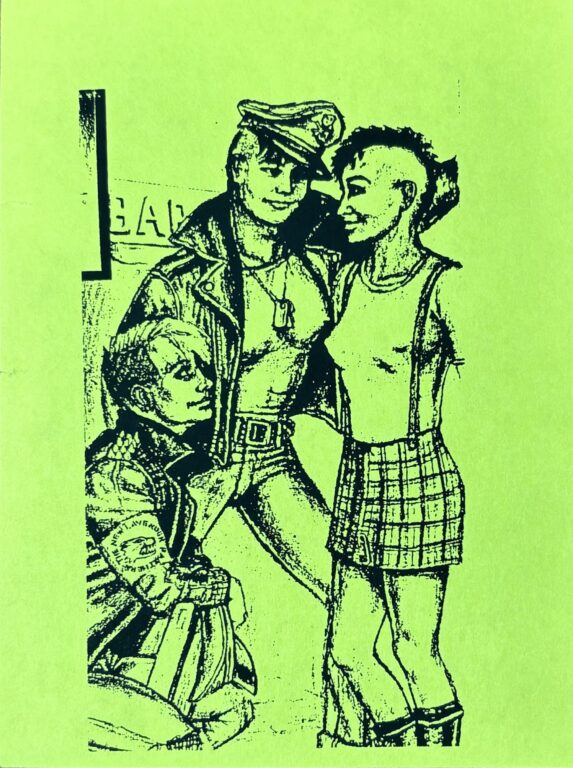
Homocore Event Flyer (F0197-02-002)
An event flyer featuring artworks by Jones titled Homocore. Flyers for Jones’s art exhibitions, shows, and film screenings like this one populate the fonds.
G.B. Jones
G.B. Jones is a Toronto-based artist, musician, filmmaker, and zinester whose drawings have been shown in galleries globally. Her work has been incredibly influential in queer and punk scenes since the 1980s and engages in themes of power, authority, and gender. She is most known for her drawing series called Tom Girls, which parodies the hyper-masculine Tom of Finland artwork, reimagining them with fantasy images of leather dykes and lustful lesbians. Additionally, Jones has directed four films, being The Troublemakers (1990), The Yo-Yo Gang (1992), The Lollipop Generation (2008), which took over 10 years to film, and The Dark End of the Street (2017). Alongside directing, Jones starred in several music videos, short, and feature-length films directed by Canadian filmmaker, photographer, artist, writer, and long-time collaborator Bruce LaBruce.
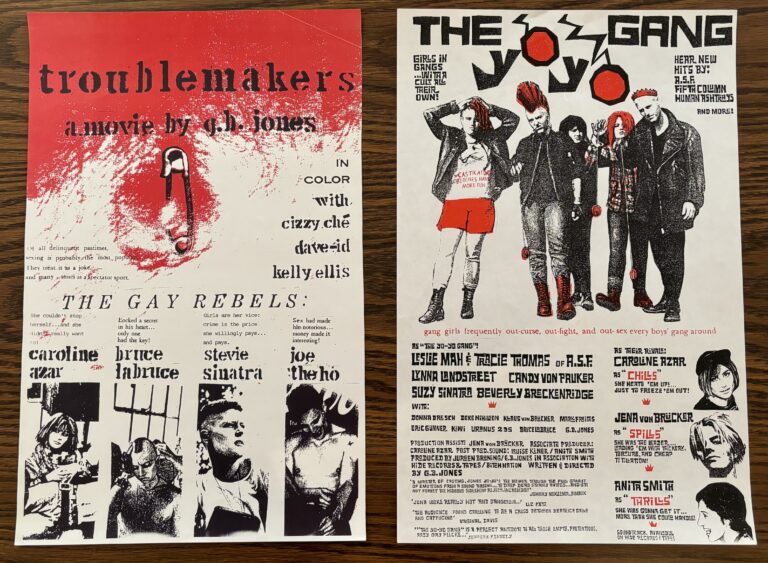
Posters for Troublemakers [1990] and The Yo-Yo Gang [1992] (F0197-02-028-003/004)
Posters for two films directed by Jones, Troublemakers (left) and The Yo-Yo Gang (right). Both posters are in a very similar style, featuring black text and red highlights with portraits of cast members.

K News No. 22 (F0197-02-043)
The 1994 newspaper from K records, the record label Fifth Column was signed to, featuring Fifth Column on the cover. The band was featured alongside bands like Kicking Giant, Beck, Cockpit, Blood Thirsty Butchers, and Dub Narcotic Sound System.
J.D.s and Queercore
Arguably Jones’s most notable contribution to queer and punk culture is her co-creation of the zine J.D.s with Bruce LaBruce, first published in 1985. Standing for Juvenile Delinquents, as well as many other J.D. combinations readers find fitting, the zine was an anti-assimilationist, anti-capitalist D.I.Y. zine featuring writing, playlists, photography, and artwork. It was through this publication that Jones first debuted her Tom Girls, as well as her other drawings.
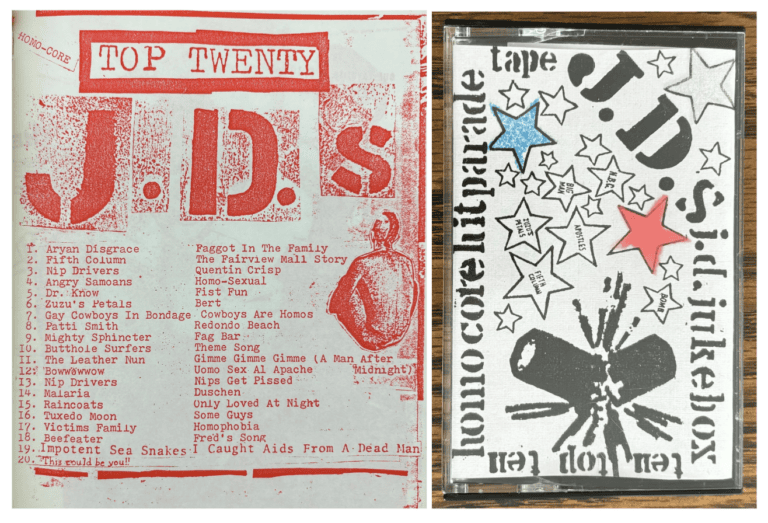
J.D.’s no. 3 [1986?] Top Twenty and Top Ten Homocore Hit Parade [1990] (F0197-03-022-001)
With music acting as large central part of the J.D.’s subject matter and surrounding culture, the zine often featured playlists and released tapes which accompanied the zine, such as the Homocore Hit Parade. Often receiving mail and submissions from readers, the 20th slot of the top twenty list is left open for a future submitter.
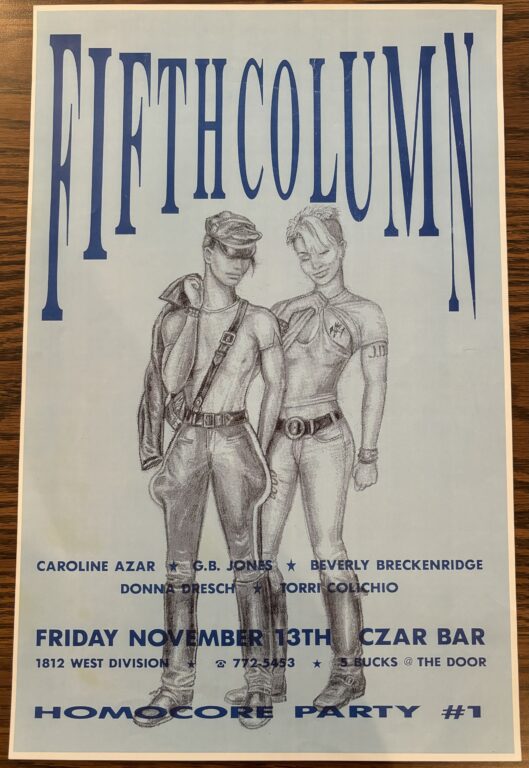
Fifth Column Homocore Party #1 [1992] (F0197-02-049-008)
A poster for a Fifth column show featuring Caroline Azar, G.B. Jones, Beverly Breckenridge, Donna Dresch, and Torri Colichio taking place at Czar Bar in Chicago. The poster features one of Jones’s Tom Girl’s drawings, tying together her various creative pursuits.
G.B. Jones’s fonds are an incredible source on not only queercore and punk history, but also Toronto’s music and art cultures.
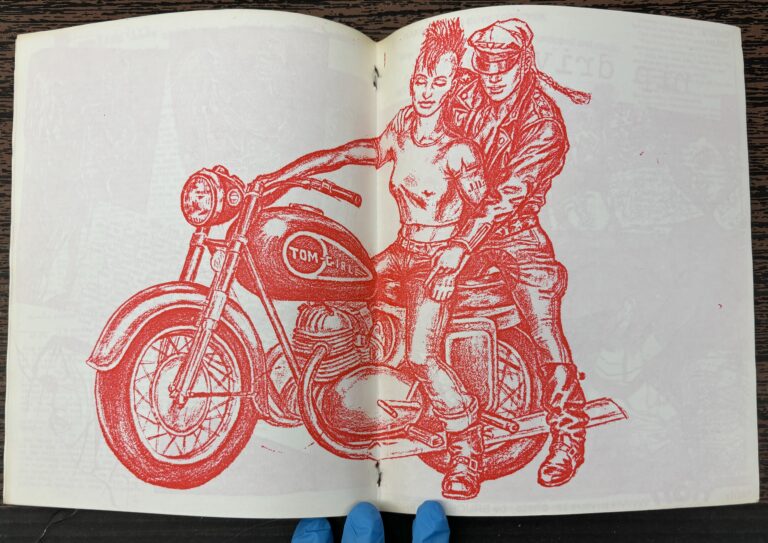
Tom Girls [1986?]
Taken from J.D.’s issue 3, this is one of many Tom Girls drawings featured in the zine throughout its run. As the centrefold for the zine, the drawing features two girls on a “Tom-Girl” motorcycle, in what is familiar as the Tom Girls’s classic leather, biker wear.
Awe, Emma N. Queercore: The Punk Movement and Their Zines. The Canadian Centre for Gender and Sexual Diversity (CCGSD), https://ccgsd-ccdgs.org/wp-content/uploads/2020/09/Queercore-Booklet.pdf.
“Fifth Column.” Britannica, 3 Jul. 2024, https://www.britannica.com/topic/fifth-column.
“Fifth Column (band).” Wikipedia, https://en.wikipedia.org/wiki/Fifth_Column_(band).
“G.B. Jones.” Cooper Cole, https://coopercolegallery.com/artist/g-b-jones/.
Hall, Jake. “Revisiting the seminal queercore movement.” Dazed, 18 Jul. 2016, https://www.dazeddigital.com/music/article/32097/1/revisiting-the-seminal-queercore-movement.
Nault, Curran. “Overview.” Queercore: Queer Punk Media Subculture, https://queercorebook.com/historical-overview/.
River, Julie. “Smells Like Queer Spirit: The Lost History of Queercore Punk.” Out Front Magazine, 5 Aug. 2022, https://www.outfrontmagazine.com/smells-like-queer-spirit-the-lost-history-of-queercore-punk/.
Author bio: Roxy Moon holds a Master of Information in Archives and Records Management from the University of Toronto’s Faculty of Information. Prior to this, they completed their BA (Hons) at UofT, where they specialized in Sexual Diversity Studies. They began working/became interested in archives and libraries in 2021 after working as an administrative record-keeper. Their research interests include community and independent archives, archives as sites for resistance and liberation, and how sexuality and gender appear in nation-state propaganda.

